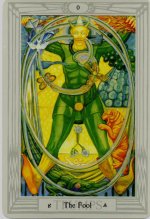Michael Sternbach
As some of you may know, I just love comparing the metaphysical systems of different times and cultures with one another. Frequently, I find that they have central ideas in common. Thus, a comparative approach tells us more about the Collective Unconscious, shared by all of humanity. Looking at an Archetypes from a variety of different perspectives serves to illuminate and amplify it further.
Chapter 50 of the Tao te ching seems to be a good example of what I mean.
From Robert Henricks' translation:
Now, the Death card in Tarot is the thirteenth of the Major Arcana, as we all know. The traveller who comes out into life and goes back into death is The Fool. He stands both at the beginning and the end of the series of the Major Arcana, so he can be attributed with both the numbers 0 and 22.
Cards that share the same checksum are seen as related with each other, like Death and The Fool, since they can both be reduced to the number 4. The fourth of the Major Arcana is The Emperor. He is another important Archetype in Taoism, but we will safe him for later and stay with The Fool.
The Fool is the eternal spiritual seeker, the original Tarot Bum undertaking the adventure of Individuation. He represents our childlike and spontaneous nature which we start out and hope to end up with. He is the wandering Taoist sage so prevalent in both Lao Tzu's and Chuang Tzu's writings. Ideally, he in fact attains (a kind of) immortality.
Chapter 50 of the Tao te ching continues:
On the Thoth version of The Fool (see the attachment), there is indeed a tiger shown which cannot injure the Fool. He is protected by his spiritual "innocence" or, in Taoist terms, state of wu wei.
Chapter 50 of the Tao te ching seems to be a good example of what I mean.
From Robert Henricks' translation:
Tao te ching said:We come out into life and go back into death.
The companions of life are thirteen;
The companions of death are thirteen;
And yet people, because they regard life as LIFE,
In all of their actions move towards the thirteen that belong to the realm of death.
Now, the Death card in Tarot is the thirteenth of the Major Arcana, as we all know. The traveller who comes out into life and goes back into death is The Fool. He stands both at the beginning and the end of the series of the Major Arcana, so he can be attributed with both the numbers 0 and 22.
Cards that share the same checksum are seen as related with each other, like Death and The Fool, since they can both be reduced to the number 4. The fourth of the Major Arcana is The Emperor. He is another important Archetype in Taoism, but we will safe him for later and stay with The Fool.
The Fool is the eternal spiritual seeker, the original Tarot Bum undertaking the adventure of Individuation. He represents our childlike and spontaneous nature which we start out and hope to end up with. He is the wandering Taoist sage so prevalent in both Lao Tzu's and Chuang Tzu's writings. Ideally, he in fact attains (a kind of) immortality.
Chapter 50 of the Tao te ching continues:
Tao te ching said:Now, why is this so?
It's because they regard life as LIFE.
You've no doubt heard of those who are good at holding on to life:
When walking through hills, they don't avoid rhinos and tigers;
When they go into battle, they don't put on armor or shields;
The rhino has no place to probe with its horn;
The tiger finds no place to put its claws.
And weapons find no place to hold their blades.
Now, why is this so?
Because there is no place for death in them.
On the Thoth version of The Fool (see the attachment), there is indeed a tiger shown which cannot injure the Fool. He is protected by his spiritual "innocence" or, in Taoist terms, state of wu wei.


